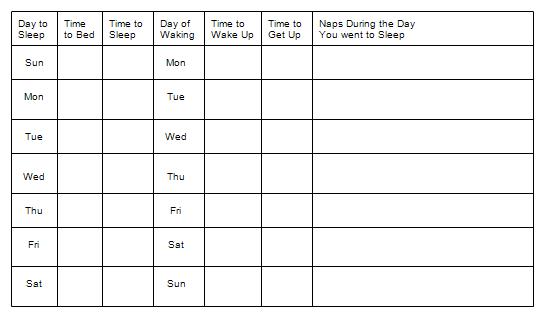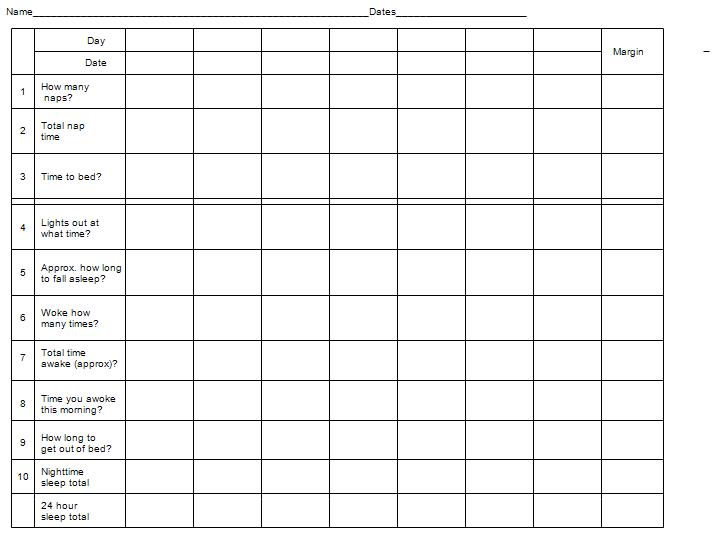SLEEP RECORDS AND LOGS
BASIC SLEEP RECORD
Stuff to keep track of
- Time to sleep, time to awaken, difference
- How long to fall asleep, how long to get out of bed in the morning
- How much time lost during the night
- Amount of nap time (including falling asleep watching TV)
Amenities
- Do it for several days
- Get averages
—————————————————————————————————-
Basic Sleep Record
Name ______________________________Day___________Date_________
At Bedtime, record the following
Naps Time Lasted Where and Why?
Started How long?
______ _________ ________________________________
______ _________ ________________________________
______ _________ ________________________________
Went to Bed at what time? __________________
The next morning, record the following:
Last night: Lights out at __________ Time to get to sleep _______________
What kept you awake?______________________________________________
Morning Woke at ________________
How long to get up? ______________
What thinking or doing?_______________________________________
———————————————————————————————————————-
BASIC SLEEP LOG FOR ONE WEEK
The following sleep log is designed to summarize the information collected in the above sleep record.

Directions:
Each line represents a night. The table begins with Sunday night, but you don’t have to. To begin with Wednesday night, draw a line across the table above the Wednesday row.
If you chose Wednesday, then fill in the time you went to bed Wednesday, and the time you think you got to sleep. Next, fill in the time you woke up Thursday and the time you got out of bed. And in the last column, put in any naps you had on Wednesday – the day you went to sleep.
When you get to Sunday, go to the top row. Your week will end at the line below Tuesday.
ADD-INS TO A BASIC SLEEP LOG
How you do add-ins depends on what you want. You can ask for comments or get ratings on an equal-appearing intervals scale, etc.
Add-ins can appear right next to a data collection point, or at the end of a day. The issue is how you can make use of the information to evaluate the person’s sleep issues.
Section 1: Nature of the Problem
- Mood and attitude during the day
- Ability to work
- Fatigue at different times of day
Section 7 and 8: Medications
- How much of each medication and when
The goal of Section 11 is to decide which part of the night to focus on. This record keeps track of a person’s sleep for a 24-hour period, with emphasis on time of night when insomnia is the greatest issue. You should modify it if you want, then make a separate copy to be filled out for each day of the week.
The record collects two kinds of information: times that events started, and elapsed time, These distinctions may need some discussion to be clear.
Once the daily information are collected, you can enter them into the sleep log to get an overview for the week
Name ______________________________Day___________Date_________
At Bedtime, record the following
Naps Time Lasted Where and Why?
Started How long?
______ _________ ________________________________
______ _________ ________________________________
______ _________ ________________________________
Went to Bed at what time? __________________
The next morning, record the following:
Last night: Lights out at __________ Time to get to sleep _______________
What kept you awake?______________________________________________
In the night Woke at Time to What Kept you Awake?
Get back
______ ______ __________________________________
______ ______ __________________________________
______ ______ __________________________________
Morning Woke at ________________
How long to get up? ______________
What thinking or doing?_______________________________________
SECTION 11 SLEEP LOG
This gives a weekly summary and overall calculations for the daily records of a patient.
To start, fill in the information at the top: Patient name and dates covered. Then in the two top rows of the table, put the days and dates. If the first night is Wednesday night, put “Wednesday” at the top of the first blank column, etc.
The first column contains the Wednesday day and night information. The table is designed to correspond to the questions in the Sleep Record.

This log gives most of the information you need to move on. For each day,
Nighttime sleep total has to be calculated for each column:
(Cell 10) = (Cell 8) – (Cell 4 + Cell 5), where (Cell 4 + Cell 5) gives time the person fell asleep.
Eg: if the light went out at 10:30 and it took 20 minutes to fall asleep, and they woke at 6:30,
Then nighttime sleep total = 6:30AM – 10:50PM = 7 hours and 40 minutes.
Then 24 hour sleep total for each column = Nighttime sleep total + Total nap time.
Once this is done, most of the calculations are in the right margin.
- Row 1 The average number of naps
- Row 2 The average time spent napping
And so on.
This information can be a basis for further exploration.
- If the average for Sleep Total is reasonable, what is the person really concerned about, and why is insomnia an issue?
- If the person awoke several times most nights (margin 6), what could be causing it? If he/she can’t get right back to sleep (margin 7), why not?
- If the person is hanging out in bed at night (margin 5) or in the morning (margin 9), what is he/she doing, and how is that affecting his/her sense of the bed as a place for sleep?
And so on.
In addition, variability within row and column can be useful.
- Row 2: Does the person nap more on some days than others? If so, why, and how does it affect sleep that night (Sleep total)?
- Row 3: Does time to bed vary from day to day, and if so, why?
You probably won’t want to calculate every margin or look at the variability in every row – only those that seem to relate to the person’s complaint and may have information that will help select a treatment for it.
The following is a copy of Section 17 Sleep Log 2b, used to record the ways that a person prepares for bed and possible relationships of preparation to sleep.